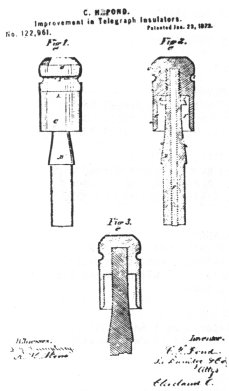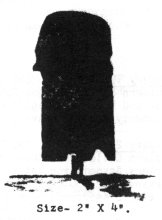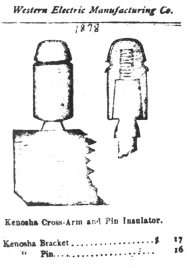Research Division
Reprinted from "INSULATORS - Crown Jewels of the Wire", December 1973, page 31
Dear Mrs. Harned,
My husband and I recently acquired an insulator which we believe to be a
companion to Chambers C.D. 432. It is identical to the one described by
Milholland, except ours shows the following embossing on the crown opposite the
side with the vertical groove: PATENT / DEC. 19, 1871
Milholland says the companion has no embossing.
Can you shed any light on the value placed on our insulator?
Also, is there any new pricing information on an old Hemingray No. 2 (C.D.
132) embossed with a 2 on one side and PATENT / DEC. 19, 1871 on the other?
Thank you for your great magazine. We've met some wonderful people through
your ads.
Sincerely,
Mrs. John McDougald
4592 Andorra Drive
North Olmsted, OH
44070
Dear Dora,
I wonder if any of your readers have ever heard of this one. I found a
Hemingray 10 C.D. 115 clear smooth base. The embossing is perfect and says
HEMINGRAY-16 MADE IN USA on the back.
Also while in Sweden this summer I found a lot of white porcelain insulators,
Terrill's book, page 70, left side. Did not see any glass except the large
French green sombrero.
Sincerely,
Herb Barker
2326 Livingston
Missoula, MT 59801
Dear Dora:
I may not be current on glass insulator research, but I believe collectors
are still wondering why the CD158.9 Boston has the "screw top". I
recently ran on to a patent which evidently covers this design.
|

|
Image text (upper):
490,560. INSULATOR Auguste J. Hauty, Saltsburg, Pa, assignor of one-third to
John Burke, same place. Filed Aug. 29,1892. Serial No. 444,405. (No model.) |
Image text (lower):
Claim. In an insulator, the combination of the threaded standard, the outer
cap having its inner periphery threaded oppositely to the standard and provided
with a longitudinal slot, and the inner or intermediate cap having its outer
periphery threaded to register with the threaded portion of the outer cap, and
its inner periphery threaded to register with the threaded portion of the
standard, substantially as and for the purposes described. |
This is Patent No. 490,560, Jan 24, 1893 by Autuste J. Hauty, Saltsburg, Pa.,
assignor of 1/3 to John Burke, same city.
The idea is that the insulator is placed on the peg and the cap is placed on
the insulator top with the line conductor positioned in the cap slot. The
insulator is then turned down onto the peg, and simultaneously the cap screws
down to firmly hold the line wire. For this to work, the top set of threads have
to be lefthand as opposed to the righthand threads on the pin hole portion.
I have speculated in my sketch at the right what the cap may have looked
like, and I assume it must have been wooden to work well and to reduce the
chance for breakage that would be caused by a glass-to-glass thread.

As with most other glass and porcelain "no-tie-wire" brainstorms,
the insulator is also provided with a normal side groove. Also as with other
such designs, I doubt that the design was very reliable in permanently holding
the line wire, and the caps were probably soon discarded in favor of using the
insulator in conventional fashion. It would be a real victory if someone located
one of the caps for this insulator, but the chances for that would appear to be
very remote.
Another insulator design with top external threads was reported on page 26 of
the June 1971 Crown Jewels, and it could also fit this patent if the top threads
are lefthand as on the Boston (the correspondent didn't say).
Jack H. Tod
Phoenix
Dear Dora:
Referring to October issue, page 18, I "JIST" happened to have what
this boy was looking for. I have sent Glenn Polasik this dope direct, and so
here it is for you (See following page.). This is a page (reduced one third)
from my forthcoming book on UNIQUE INSULATORS.
As you will see from the copy, my specimen does not have the patent date on
it and so was doubly glad to get this new information.
Have just made a display of all the STANDARD knobs that I have. It is real
interesting.
Gerald Brown
Two Buttes, CO 81084
|

|
|

|
An insulator which fits patent No. 122,961 which is in my collection. It has
no patent date but I have information from Glenn Polasik of Green Bay Wis. of one he has which has the 1872 patent date on it.
Forest Jones has one like this which he thinks is made of carbon. I have not
seen it.
|
|
|

|

|
|
